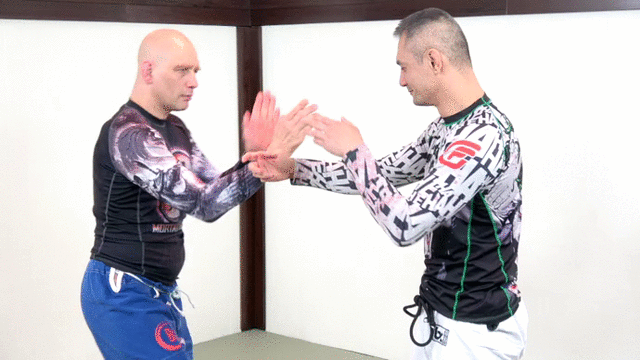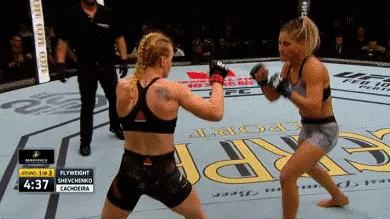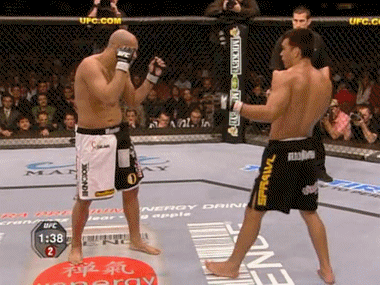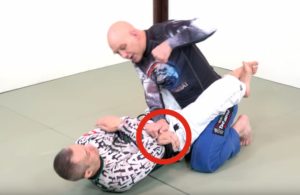
This is bound to be controversial, but I don’t think that trapping works in real self defense situations.
At least not the way it’s normally taught and trained.
Here’s my video on the topic, along with a few examples of where some of these techniques might actually be useful…
What is Trapping Hands?
Trapping hands is an aspect of some kung fu systems in which you use your arms to tie up and control your opponent’s arms in order to control him and land your own strikes. It’s found in many different styles but is best known from wing chun kung fu and jun fan kung fu.
Typical techniques in trapping include the pak sao (slapping hand), lop sao (pulling hand), biu sao (darting hand), huen sao (circling hand) and many others.
The cool part is when you and a training partner start linking these moves together into extended sequences and drills. Hands and fists are flying all over the place and you feel like some sort of unstoppable kung fu killer robot.
I’ve trained trapping hands with at least 4 different instructors and it’s really fun.
But…
There’s Trouble with Trapping
The trouble with these extended trapping sequences is that they almost NEVER work under real pressure. They don’t work reliably in full contact sparring, you don’t see them in MMA or in streetfights.
Now it’s true, you may see isolated cases of fighters using one single trapping technique to set up a strike or combination occasionally in a match. Here are some examples of a trap to hit inside the octagon…



I’ve also seen fighters in Thai Boxing and Lethwei use similar trapping techniques to set up knees and elbows.
But notice how these are all single trapping movements, and almost always a pak sao (the slapping hand, or a pawing motion to get the other guy’s arm out of the way).
But what you NEVER see is an extended sequence that goes pak sao to lop sao to pak sao to huen sao to jeet chung choi (i.e. anything resembling a classical trapping sequence).
Why is that?
Why Don’t Extended Trapping Sequences Work?
First of all, trapping is really hard to pull off against someone using boxing punches thrown from a boxer’s stance with typical boxing hand positions.
Secondly, and even more fundamentally, those extended trapping sequences rely on the two combatants staying at a range with about 1 to 2 feet of separation. But when people are fighting for real that range is a usually a temporary phenomenon.
After the first trap the two fighters almost always either 1) clinch, or 2) separate.
This rant may seem a bit pedantic, a TON of people spend a TON of time training these unrealistic extended sequences that will never work in real life.
Fundamentally, under pressure you’re revert to your training. And if your training is unrealistic then you’ll be sadly disappointed in your skills.
When Does Trapping Work?
I think people would be better off and their skills much more applicable if they worked their boxing and clinching skills, and didn’t spend as much time in a make-believe world where people stay in trapping range and move their arms like kung fu robots.
Once you can throw a powerful jab, defend a right cross, and feel competent at the basic ranges of fighting, then you can maybe add the occasional pak sao or lop sao to your sparring.
That pak sao is the secret spice though, it’s not a main ingredient to build your recipe around.
Another time that trapping can work is on the ground, especially in ground and pound situations.
The range during ground and pound is essentially the same range at which most classical kung fu trapping occurs (1 to 2 feet) and so it’s much harder for your opponent to back up out of trapping range.
You still don’t see long classical trapping combinations though, but the odds of linking together one or two traps becomes higher. But if this barrage continues for any length of time you’re essentially right back into something that looks an awful lot like gripfighting from the clinch, just with one person flat on his back.
I show a couple of examples of possible ground and pound combinations in the second half of the video at the top of this page, so go check it out if you want a deeper explanation of ground and pound trapping.
What About Trapping as a Training Method?
Sometimes the argument for training extended trapping goes something like this…
“Yes, we know that it’s unlikely that you’ll be able to link more than one or two traps in a real fight, but by training these long sequences over and over we get more reps in, develop muscle memory, and make these moves instinctive.”
I actually think there is some truth to this argument.
Repetition does make perfect, and if you want to link your reps together into a sequence or a drill that’s great.
Just don’t mistake the finger pointing at the moon for the moon itself; be honest with yourself and remember what you’re doing is a drill and not a fighting technique in itself.
Even 10,000 reps of your fancy trapping sequence later it’s almost impossible that this sequence will ever manifest itself in sparring, in a match, or in a real fight. Remind yourself of this fact by doing some kickboxing sparring once in a while and see how much of your trapping you can pull off before it immediately proceeds into the clinch.
Trapping is a garnish that occasionally gets added to the meal, not the meal itself.
That’s my rant for the day.
Good luck with your training,
Stephan
Want More Opinionated Martial Arts Advice?
I put out a lot of my best information in email form.
In the newsletter you’ll get my very best tips on training, fighting, and defending yourself in the street.
Click here to find out more, or – even easier – just enter your best email in the box below.
Get My FREE Self Defense Tips by Email
